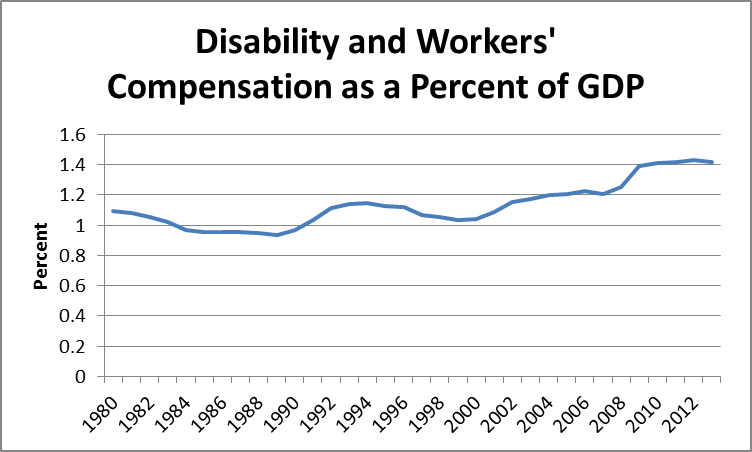July 21, 2017
The Washington Post has been running a multi-part series on the country’s disability programs. The premise, as stated in the most recent installment, is that we are seeing:
“…decades-long surge in the nation’s disability rolls.”
The formula then involves profiling one or more families who depend on disability payments from the government instead of work for their primary source of income. Usually, the profiles show family members to be reluctant to work and to have drug problems and other unhealthy habits.
While this situation undoubtedly describes a substantial number of people in the United States, the idea that the number of people getting disability payments is exploding is a Washington Post invention, not a fact in the real world. The graph below shows disability payments as a share of GDP from 1980 to 2013.

Source: OECD.
While the share of GDP going to disability payments did rise over this 33 year period, the increase was just over 0.3 percentage points, a rise of 30 percent. Furthermore, Social Security disability payments, the largest component of this spending, has fallen by 0.07 percentage points of GDP over the years from 2013 to 2016, leaving an increase of less than 25 percent measured as a share of GDP over 46 years. (The Social Security Trustees project payments as a share of GDP will fall somewhat more this year.)
Even this modest increase is due in large part to the raising of the normal retirement age for Social Security from 65 to 66. (People who are receiving disability payments can get them until they reach the normal retirement age, at which point they collect their Social Security retirement benefits instead.) Also, the fact that more women are working more years means that a much larger share of the population qualifies for Social Security disability benefits.
When these factors are taken into account, it is pretty hard to find much evidence for the “decades-long surge in the nation’s disability rolls” that is the background for this series. It is also worth noting that, even with this “surge” the United States ranks near the bottom among wealthy countries in disability payments as a share of GDP. For example, Germany paid out almost 2.1 percent of GDP in disability related payments in 2013, nearly 50 percent more than the United States. The Netherlands paid out 3.1 percent of GDP, more than twice as much as the United States.
It is also worth noting that both these countries have considerably higher labor force participation rates for prime-age (ages 25 to 54) workers than the United States. This suggests that overly generous disability payments are not a major factor discouraging work in the United States.







Comments